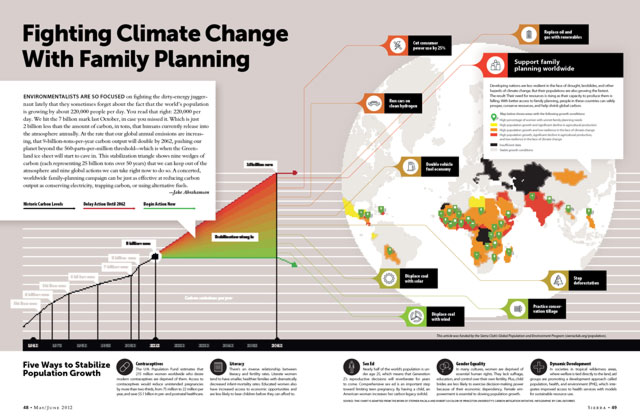sierraclub.org - sierra magazine - may/june 2012 - fighting climate change with family planning
By Jake Abrahamson
Environmentalists are so focused on fighting the dirty-energy juggernaut lately that they sometimes forget about the fact that the world's population is growing by about 220,000 people per day. You read that right: 220,000 per day. We hit the 7 billion mark last October, in case you missed it. Which is just 2 billion less than the amount of carbon, in tons, that humans currently release into the atmosphere annually.
At the rate that our global annual emissions are increasing, that 9-billion-tons-per-year carbon output will double by 2062, pushing our planet beyond the 560-parts-per-million threshold—which is when the Greenland ice sheet will start to cave in. This stabilization triangle shows nine wedges of carbon (each representing 25 billion tons over 50 years) that we can keep out of the atmosphere and nine global actions we can take right now to do so. A concerted, worldwide family-planning campaign can be just as effective at reducing carbon output as conserving electricity, trapping carbon, or using alternative fuels.
Click on the infographic below to see at full size.

Five Ways to Stabilize Population Growth
Contraceptives
The U.N. Population Fund estimates that 215 million women worldwide who desire modern contraceptives are deprived of them. Access to contraceptives would reduce unintended pregnancies by more than two-thirds, from 75 million to 22 million per year, and save $5.1 billion in pre- and postnatal healthcare.
Literacy
There's an inverse relationship between literacy and fertility rates. Literate women tend to have smaller, healthier families with dramatically decreased infant-mortality rates. Educated women also have increased access to economic opportunities and are less likely to bear children before they can afford to.
Sex Ed
Nearly half of the world's population is under age 25, which means that Generation Z's reproductive decisions will reverberate for years to come. Comprehensive sex ed is an important step toward limiting teen pregnancy. By having a child, an American woman increases her carbon legacy sixfold.
Gender Equality
In many cultures, women are deprived of essential human rights. They lack suffrage, education, and control over their own fertility. Plus, child brides are less likely to exercise decision-making power because of their economic dependency. Female empowerment is essential to slowing population growth.
Dynamic Development
In societies in tropical wilderness areas, where welfare is tied directly to the land, aid groups are promoting a development approach called population, health, and environment (PHE), which integrates improved access to health services with models for sustainable resource use.
This article was funded by the Sierra Club's Global Population and Environment program.
Source: The chart is adapted from the work of Stephen Pacala and Robert Socolow of Princeton University's Carbon Mitigation Initiative; and from Population Action International. Infographic by Carl DeTorres
This article has been corrected, and the infographic updated.